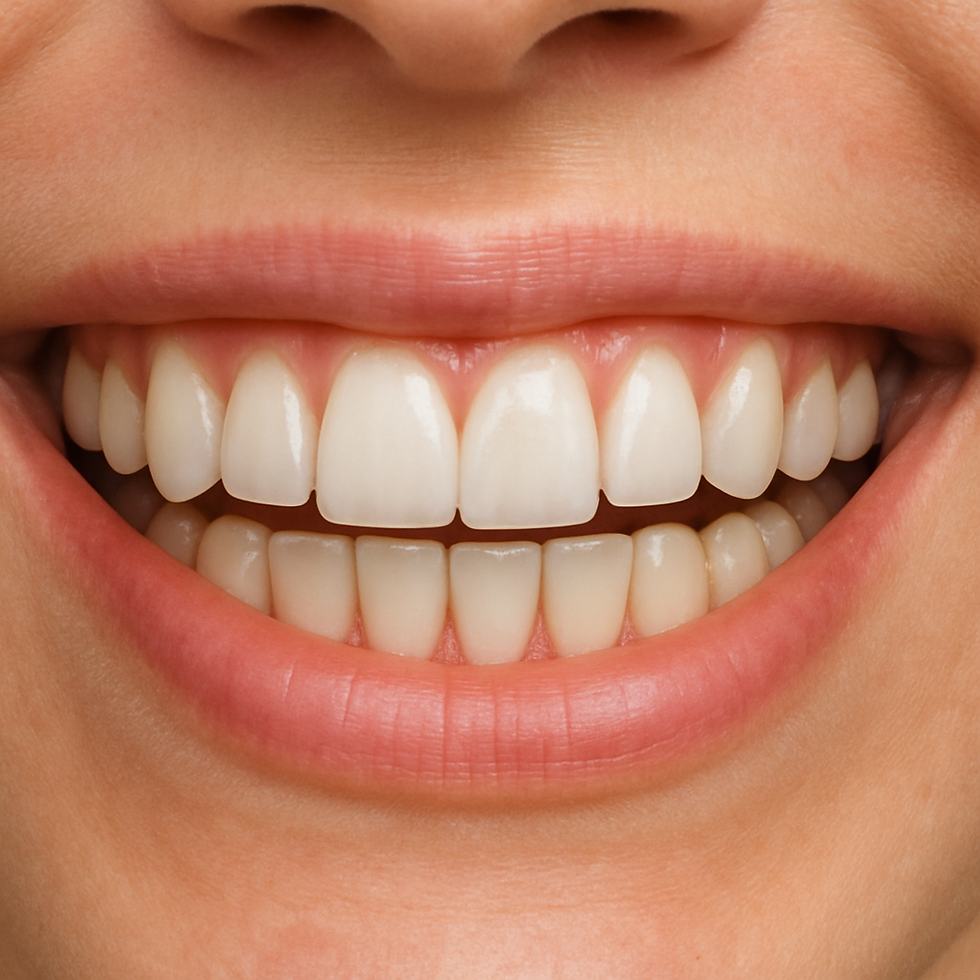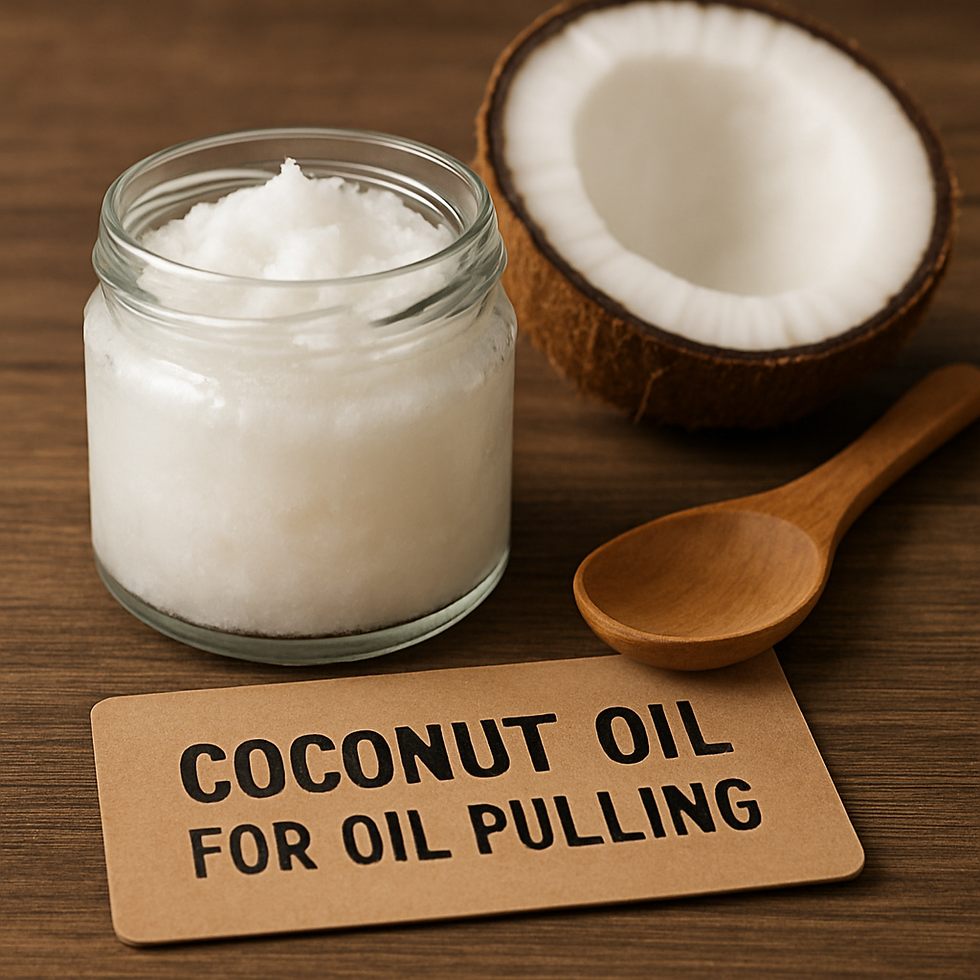How to remove brown stains from teeth naturally
- plurefy com
- Aug 19
- 6 min read

Brown stains on teeth can be both frustrating and embarrassing, impacting not only your smile but also your self-confidence. Although professional dental treatments are effective, they can be expensive. Fortunately, there are natural ways to remove these stains and maintain your oral hygiene. This article will discuss how to naturally remove brown stains from teeth, offering practical oral hygiene tips to improve your smile.
Tooth discoloration can occur for various reasons, including dietary habits, lifestyle choices, and certain medical conditions. Brown stains often result from consuming foods and beverages that cause staining, such as coffee, tea, and red wine. Smoking and poor oral hygiene also significantly contribute to the development of these unsightly stains.
Causes of Tooth Discoloration
Diet plays a key role in the color of your teeth. Dark-colored foods and drinks, like coffee, tea, and red wine, contain tannins that can lead to staining. Acidic foods and drinks can also erode enamel, making it easier for stains to set in. Additionally, certain medications, such as tetracycline antibiotics, can cause intrinsic tooth discoloration when taken during tooth development.
Lifestyle Influences
Lifestyle choices, such as smoking or chewing tobacco, are major contributors to tooth discoloration. Nicotine and tar in tobacco can cause yellow or brown stains. Moreover, poor oral hygiene allows plaque and tartar to accumulate, both of which can discolor teeth. Over time, these factors can significantly alter the appearance of your teeth.
Medical and Genetic Factors
Certain medical conditions and treatments, like radiation and chemotherapy, can lead to tooth discoloration. Genetic predisposition also plays a role; some individuals naturally have enamel that is more susceptible to discoloration. Understanding these factors can help in addressing and preventing further staining.
Natural Remedies to Remove Brown Stains
Baking Soda and Hydrogen Peroxide
One of the simplest yet highly effective methods for whitening teeth is using baking soda and hydrogen peroxide. Baking soda serves as a gentle abrasive, helping to remove surface stains, while hydrogen peroxide acts as a natural bleaching agent.
How to Use Baking Soda and Hydrogen Peroxide
Create a paste by mixing a small amount of baking soda with a few drops of hydrogen peroxide.
Brush your teeth gently with this paste for two minutes.
Rinse thoroughly with water.
This mixture can effectively remove stains, but caution is advised. Overuse can lead to enamel erosion, causing sensitivity. Brush gently to prevent damage to your teeth.
Frequency of Use
Apply this remedy once or twice a week. Excessive use may result in enamel erosion, so moderation is crucial. If you experience increased sensitivity, reduce usage and consult a dentist to ensure your enamel is protected.
Oil Pulling

Oil pulling is an ancient technique involving swishing oil in your mouth to eliminate bacteria and enhance oral hygiene. Coconut oil is a favored option due to its pleasant taste and additional health benefits.
Steps for Effective Oil Pulling
Swish a tablespoon of coconut oil in your mouth for 15-20 minutes.
Spit the oil into a trash can (not the sink, as it can harden and clog pipes).
Rinse your mouth with warm water and brush your teeth as usual.
Oil pulling not only helps in stain removal but also promotes overall oral health by reducing plaque and bacteria. Consistency is key for achieving optimal results.
Advantages Beyond Stain Removal
Besides whitening, oil pulling can enhance gum health and decrease bad breath. Coconut oil contains lauric acid, which has antimicrobial properties that help minimize harmful bacteria in the mouth. This makes oil pulling a comprehensive approach to oral hygiene.
Apple Cider Vinegar
Apple cider vinegar is recognized for its natural bleaching abilities and stain removal properties. However, due to its acidity, it's crucial to use it carefully to avoid enamel damage.
Safe Use of Apple Cider Vinegar
Mix apple cider vinegar with water in a 1:2 ratio.
Swish the mixture in your mouth for about one minute.
Rinse thoroughly with water.
Apple cider vinegar should be used cautiously because of its high acidity. Diluting it is vital to protect tooth enamel from erosion, which can lead to increased sensitivity and damage.
Limitations and Precautions
Frequency: Restrict this method to a few times a week to prevent weakening tooth enamel. It's important to watch for any signs of increased sensitivity or irritation and adjust usage accordingly.
ngly.
Dietary Changes to Prevent Tooth Discoloration
Limit Foods and Beverages That Cause Staining
Certain foods and drinks are known for causing tooth discoloration. These include:
Coffee and tea
Red wine
Dark berries
Soy sauce
Reducing your intake of these items can help prevent further staining. If you do consume them, consider rinsing your mouth with water afterward to lessen their staining effects.
Strategies to Minimize Staining
Aside from reducing consumption, you can use a straw when drinking beverages like coffee or tea to minimize contact with your teeth. Another approach is to pair staining foods with a glass of water to immediately rinse away pigments.
Increase Crunchy Fruits and Vegetables
by Jennifer Chen (https://unsplash.com/@jnnfrchn)
Eating crunchy fruits and vegetables like apples, carrots, and celery can naturally scrub away plaque and surface stains. They also stimulate saliva production, which neutralizes acids and washes away food particles.
Benefits of Crunchy Foods
Crunchy fruits and vegetables act like natural toothbrushes, gently scrubbing your teeth as you chew. Additionally, the increased saliva production they stimulate is beneficial for oral health, as it helps wash away bacteria and food particles.
Suggested Additions to Your Diet
Incorporate a variety of crunchy fruits and vegetables into your diet for overall health benefits. Options include not just apples and carrots, but also celery, broccoli, and pears, all of which can contribute to a cleaner mouth and healthier teeth.
Stay Hydrated
Drinking plenty of water throughout the day helps wash away food particles and bacteria. It also keeps your mouth hydrated, reducing the risk of stain-causing plaque buildup.
The Role of Hydration in Oral Health
Water is essential for maintaining a healthy mouth. It helps rinse away leftover food particles that could contribute to plaque buildup and provides a medium for the natural cleansing action of saliva.
Tips for Staying Hydrated
Aim to drink at least eight glasses of water a day, and consider carrying a reusable water bottle to make it easier to stay hydrated. Drinking water after meals can help neutralize acidity and reduce the risk of staining.
.
Good Oral Hygiene Practices
Consistent Brushing and Flossing
Brushing twice daily and flossing every day are essential for maintaining oral hygiene and preventing teeth discoloration. Use a soft-bristled toothbrush and fluoride toothpaste to gently clean your teeth and remove surface stains.
Effective Brushing Techniques
Make sure you brush for at least two minutes, covering all tooth surfaces. Use a gentle, circular motion to protect your gums and enamel.
Significance of Flossing
Flossing eliminates food particles and plaque from between your teeth where a toothbrush can't reach. This helps reduce the risk of cavities and gum disease, both of which can lead to tooth discoloration over time.
Opt for a Whitening Toothpaste
Consider using a whitening toothpaste that contains gentle abrasives and ingredients aimed at removing stains. These toothpastes can help maintain a brighter smile when used regularly.
Choosing the Appropriate Whitening Toothpaste
When selecting a whitening toothpaste, look for products with the ADA Seal of Acceptance to ensure they are safe and effective. Be aware that some whitening toothpastes may cause sensitivity, so you might need to try a few to find one that works for you without causing discomfort.
Long-term Advantages of Whitening Toothpaste
Regular use of whitening toothpaste can help prevent new stains while maintaining the natural whiteness of your teeth. It's an effective way to complement other natural whitening methods.
Rinse with Mouthwash
Adding an antibacterial mouthwash to your routine can help reduce bacteria that contribute to plaque and stains. Choose an alcohol-free mouthwash to avoid drying out your mouth.
Advantages of Antibacterial Mouthwash
Mouthwash can reach areas a toothbrush might miss, reducing bacteria and freshening breath. Using mouthwash daily can enhance your oral hygiene routine and provide additional protection against stains.
Choosing the Right Mouthwash
Select a mouthwash that meets your specific needs, whether it's for whitening, reducing plaque, or freshening breath. Ensure it is alcohol-free to prevent dry mouth, which can worsen staining and oral health issues.
When to See a Dentist
While natural remedies and good oral hygiene can help manage and reduce brown stains, some cases may require professional intervention. If stains persist despite your efforts, or if you experience tooth sensitivity or other dental issues, consult a dentist. They can provide targeted treatments and advice tailored to your specific needs.
Identifying When Professional Assistance is Necessary
If you notice that stains are not improving or are worsening despite consistent natural methods, it's time to seek professional advice. Persistent discoloration can indicate underlying dental issues that need addressing.
Understanding Professional Treatments
Professional treatments, such as in-office whitening or veneers, may be recommended by your dentist. These treatments can provide more immediate and dramatic results, especially for stains that resist natural methods.
Importance of Regular Dental Visits
Regular dental check-ups are crucial for maintaining oral health. Dentists can detect early signs of dental problems and provide guidance on preventing tooth discoloration. Aim to visit your dentist every six months for optimal care.
.
Conclusion
Brown stains on teeth can be bothersome, but with the right natural remedies and oral hygiene practices, you can work towards a whiter, healthier smile. Remember to be consistent with your efforts and give these methods time to show results. By making small changes to your routine and diet, you can achieve the confidence of a brighter smile naturally.










Comments